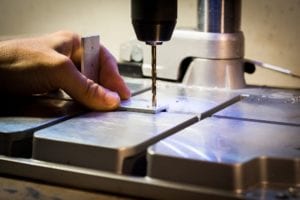 Precision metal stamping is a cold-form manufacturing process that converts metal sheets into desired shapes—be it parts, components, or finished products—for a variety of applications. In metal fabrication shops or manufacturing operations, metal sheets, known as blanks, are fed through the tool and die surface of stamping presses to shape and shear the blanks into a finished three-dimensional object. Precision metal stamping services allow for mass production of complex parts in any quantity for nearly all industries.
Precision metal stamping is a cold-form manufacturing process that converts metal sheets into desired shapes—be it parts, components, or finished products—for a variety of applications. In metal fabrication shops or manufacturing operations, metal sheets, known as blanks, are fed through the tool and die surface of stamping presses to shape and shear the blanks into a finished three-dimensional object. Precision metal stamping services allow for mass production of complex parts in any quantity for nearly all industries.
The automotive industry, building and construction, appliance manufacturing, aviation, energy, and many more industries rely on metal components produced by precision metal stamping utilizing various stamping techniques for production. Techniques include punching, blanking, bending, embossing, coining, and deep drawing are all stamping techniques used to shape the metal.
Stamping Techniques
Punching and blanking are techniques that require precision metal stamping to cut the workpiece into a specific shape. Each technique is an economical method. Punching is a process that punches holes of varying sizes and shapes into metal sheets using a die or dies of a specific diameter and design. The process creates perforated metal sheets that can be used, say, as vent covers or air ducts for machinery or computers. Blanking is just the opposite technique—it cuts the primary material away from the metal sheet to create the desired component from it.
Bending is a stamping technique that shapes metal into familiar L, U, or V-shaped components or parts, such as hinges or brackets. The stamping process deforms or bends the blank form on a single axis to the desired shape.
The process of forming a raised or recessed design in the metal sheet is the technique called embossing. To emboss, the stamping machine presses a blank form against a die or dies that contain a specific shape or design, or by feeding the blank material under a roller die. Embossing stamps information such as serial numbers, brand names or even logos onto product parts or components.
Coining is another technique of precision metal stamping. Similar to embossing, the process stamps intricate details into a metal form while placed between a die and the press.
Deep drawing is another technique of precision metal stamping. It produces three-dimensional objects like tubes from sheet materials. The process utilizes CAD/CAM computer-generated designs to produce three-dimensional objects such as cans or tubes from metal sheets.
Precision metal stamping is a relatively low-cost process that can produce precise identical shapes from metal at a high rate of speed. The stamping parts are interchangeable allowing for the mass production of different types of parts. A wide variety of ferrous and non-ferrous metals can be used for stamping such as aluminum and aluminum-clad copper, copper, beryllium copper, brass, bronze, elgiloy, Hastelloy, high carbon steel, low carbon steel, phosphor bronze, many stainless steel grades, titanium, and noble metals. The wide variety of metals that can be stamped lends itself well to the wide range of products and components that are produced by precision metal stamping.
Precision metal stamping serves nearly all industrial sectors. Manufacturers of appliances, the automotive industry, construction, the electronics and electrical industry, the medical field, the defense industry, and plumbing and HVAC, to name a few. For companies and industries that require mass-produced metal-pressed components with consistency and uniformity, precision metal stamping offers a cost-effective surface finishing solution.
Trusted Precision Manufacturers
James Spring & Wire Company performs precision metal stamping operations of varying techniques on materials up to 0.093 inches thick with an acceptable range of ferrous and non-ferrous metals available. Our metal stamping services is suitable for forming metal sheets into desired parts with excellent repeatability. The company also offers in-house tooling fabrication services in support of its stamping capabilities. Secondary finishing services include heat treatment, surface treatment, and plating, for the stamped components.

